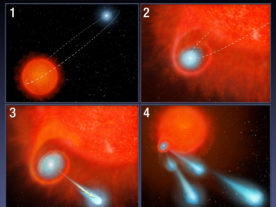
The Orbital ATK Antares rocket, with the Cygnus spacecraft onboard, launches from Pad-0A, Monday, Oct. 17, 2016 at NASA’s Wallops Flight Facility in Virginia. Orbital ATK’s sixth contracted cargo resupply mission with NASA to the International Space Station is delivering over 5,100 pounds of science and research, crew supplies and vehicle hardware to the orbital laboratory and its crew. Photo Credit: (NASA/Bill Ingalls)
UPDATE: An Orbital ATK Antares 230 rocket carrying its Cygnus cargo spacecraft (pdf) was successfully sent into space at 7:45PM EDT (2245 UTC) on Monday, October 17th from the refurbished Pad 0A at the Mid-Atlantic Regional Spaceport.
The launch site is located on the southern tip of NASA’s Wallops Island Flight facility on the eastern shore of Virginia.
Monday’s launch marks the aerospace company’s return to the Virginia launch site after its last attempt to do so, on October 28, 2014, ended with a catastrophic explosion and fire just six seconds after lift-off.
The Antares rocket, Cygnus spacecraft, as well as its payload were all destroyed in the fiery accident.
NASA reported the explosion also caused significant damage to the launch pad which has been repaired and upgraded to accommodate an upgraded Antares rocket.
Along with the improved launch vehicle, the Cygnus spacecraft itself was also upgraded to allow for increased payload capacity. The enhanced cargo ship, which first went into space in December 2015, also sports new fuel tanks and UltraFlex solar arrays (pdf).
Orbital ATK has a tradition of naming each of its Cygnus spacecraft after deceased astronauts. This mission’s spacecraft is named in honor of the late Alan G. Poindexter, a former astronaut and naval aviator. Poindexter, who was selected for NASA’s astronaut program in 1998, flew on two space shuttle missions during his career as an astronaut.
This resupply mission, called OA-5, is carrying 2,313 kg of material that includes food, supplies, provisions and emergency equipment for the ISS crew, as well as the Spacecraft Fire Experiment-II or Saffire-II that will study the behavior of combustion in microgravity.

The Orbital Sciences Corporation Antares rocket, with the Cygnus spacecraft onboard suffers a catastrophic anomaly moments after launch on October 28, 2014 from the Mid-Atlantic Regional Spaceport at NASA’s Wallops Flight Facility in Virginia. (NASA)
NASA says the Cygnus is scheduled to arrive at the space station on Sunday, October 23rd, which is a bit later than usual.
Its arrival was delayed to allow for the docking and reception of a Soyuz spacecraft carrying three new ISS crew members on Friday, October 21st.
NASA astronaut Shane Kimbrough, along with cosmonauts Sergey Ryzhikov and Andrey Borisenko of the Russian space agency Roscosmos are scheduled to be sent to the International Space Station from the Baikonur Cosmodrome in Kazakhstan on Wednesday, October 19th at 0805 UTC.
After Cygnus’ arrival at the ISS, crewmembers Takuya Onishi of the Japan Aerospace Exploration Agency and NASA’s Kate Rubins will use the robotic arm of the space station’s Mobile Servicing System to grab, rotate and install Cygnus on the bottom of the station’s Unity module.
According to NASA, the cargo ship will remain attached to the ISS for a little over three weeks to allow ISS crewmembers to unload the new supplies and then pack it with waste for disposal.
Cygnus is scheduled to leave the ISS and head for Earth on November 18th. The space agency says the spacecraft and its load of garbage is expected to burn up as it reenters the atmosphere.
Launch of ISS Resupply Mission 0A-5 on October 17, 2016 (NASA)






















Comments are closed.